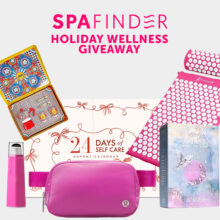4 Ways to Introduce Yourself to Holistic Health at the Spa
- Published: Wednesday, October 22nd 2014
- in Living Well
 Research consistently shows that if people adopted a healthier lifestyle, much of today’s chronic disease could be prevented. In fact, we might be able to prevent up to 80 percent of heart disease and diabetes, half of all strokes, and a third of cancers by eating a healthy diet, getting regular exercise, maintaining a healthy weight, not smoking, reducing our exposure to environmental toxins, managing our stress, and maintaining healthy relationships – staggering when you actually think about it. Even with all this research, many western-trained physicians are still not adequately taught to provide effective guidance when it comes to nutrition, exercise, stress management, or environmental health.
Research consistently shows that if people adopted a healthier lifestyle, much of today’s chronic disease could be prevented. In fact, we might be able to prevent up to 80 percent of heart disease and diabetes, half of all strokes, and a third of cancers by eating a healthy diet, getting regular exercise, maintaining a healthy weight, not smoking, reducing our exposure to environmental toxins, managing our stress, and maintaining healthy relationships – staggering when you actually think about it. Even with all this research, many western-trained physicians are still not adequately taught to provide effective guidance when it comes to nutrition, exercise, stress management, or environmental health.
It is from this acknowledgement that the field of holistic health has emerged. It rests upon the notion of wholeness and the belief that healing happens when the body, mind, social, and spiritual aspects of the individual are brought into balance. It emphasizes prevention and beyond that, it actively promotes health. This way of looking at health and wholeness is becoming increasingly popular as more and more people are seeking out meditation, acupuncture, massage, organic foods, and other self-care approaches to improve their wellbeing.
While pampering is still important, modern spa-goers are looking for not only 90 minutes of massage and facial bliss, but also for tools that will help them for a lifetime of wellbeing. People are taking responsibility for their health, and acknowledging that their health doesn’t only come down to diet and exercise, but to their overall wellbeing. Here are just a few of the ways that holistic health and healing are becoming integrated into the modern spa setting:
Nutrition
While some things may not be in your control when it comes to your health, you can control what you put on your fork! We know that the Standard American Diet, yes the SAD diet, is primarily driving heart disease, diabetes, obesity, and even cancer in this country. But food is pleasure, as well as fuel, so finding the right nutritional approach for you is important. Could gluten be a problem? Food sensitivities? Have you chosen to go vegan but not sure if you are getting all the nutrients you need? Does that vitamin you take really provide the optimal nutrients for your gender, age, and lifestyle? Do you mindlessly eat? Could mindfulness training help manage those cravings? These are important questions to ask and the truth is that many of us are overwhelmed trying to figure it out on our own. I am delighted that more spas are offering the services of registered dietitians and nutritionists, making this important information more widely available to those who are looking to take charge of their plate!
Exercise and Weight
It’s no secret that regular movement and maintaining a healthy body weight are two keys to good health. Yet, we all know how challenging both can be in the busyness of our lives. Chasing the pounds on the scale is a much too common spectator sport and the surprising fact is that number on the scale doesn’t really give you much useful information! A scale tells you the total weight off all your tissues, not your percentage of body fat or lean tissue mass. I had one patient who ran religiously three hours every week and while her cardio was tip-top and body weight was in the normal range, imagine her surprise when she found out she had 26 percent body fat! By trading in some cardio for resistance training, she dropped 6 inches and 7 percent body fat in 12 weeks! We all want to exercise smart and effectively. I suggest having your body composition assessed (ex. BodPod) and then work with a personal trainer or exercise physiologist to learn how you can maximum the benefit of your workout in the minimum amount of time.
Meditation
Long revered in Eastern traditions, a growing body of evidence shows the myriad of ways meditation can improve our health. Whether you choose a walking, sitting, or chanting meditation, or just want to clear your mind during a yoga class, science shows that regular practice can increase self-awareness, reduce stress, improve heart disease, lower blood pressure, and even change the very structure of your brain! It is one of the most effective ways I know to bring a sense of contentment and calm focus into our busy lives. Meditation can be done by anyone, anywhere. Take a class, buy a book, or get an app for your phone – whatever it takes, just get started.
Acupuncture
Acupuncture is one aspect of Traditional Chinese Medicine that has become very popular in the United States. While it has been used for millennia to treat a wide range of ailments, modern science has shown that it can be effective for relieving muscle tension, easing pain, preventing and treating migraines, reducing menopausal hot flashes, and much more. I often refer patients for acupuncture treatments, as it can be a safe and effective alternative for many conditions. While it used to be hard to find a licensed acupuncturist, an increasing number of spas are including these specialized practitioners on their staff.
About the Author: Tieraona Low Dog, MD is an internationally recognized expert in integrative medicine and holistic health and serves as the Chief Medical Director for Well & Being. Dr. Low Dog was appointed by President Bill Clinton to the White House Commission on Complementary and Alternative Medicine Policy, served as the elected Chair of the US Pharmacopeia Dietary Supplements and Botanicals Expert Panel, has been an invited speaker to more than 550 scientific/medical conferences, published 38 peer-reviewed scientific articles, written 20 chapters for medical textbooks, and is the author of two National Geographic books, Healthy at Home and Life is Your Best Medicine. She has appeared on E!, CNN, ABC’s 20/20, and is a frequent guest on the Dr. Oz show and NPR’s the People’s Pharmacy.



